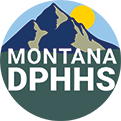Substance Use Disorder Services and Resources
The Treatment Bureau is responsible for the certification of Mental Health Professional Person, State Approval, and development of Medicaid Manual for both SUD and Behavioral Health Services. The Bureau ensures services are meeting federal and state standards efficiently and effectively. The Bureau works with Office of Inspector General (OIG) to provide routine monitoring of programs. Bureau also reviews and analyzes Medicaid billing practices with SURS and Fraud unit to review costs to ensure practices are being followed by reviewing records from SUD programs that have been licensed by OIG and state approved.
SUD Programs interested in becoming state approved can click on the link provided above. Cody Magpie is the current SUD Program Officer that oversees approving state approval and can be reached at Cody.Magpie@mt.gov and
If you are a provider from one of the state approved SUD treatment program on the list and identify any items that may be incorrect or outdated. Please contact the SUD Program Officer via email or by phone which are indicated below. The list will be updated at least quarterly each year, however will be frequent as new information is provided and/or a new state approved SUD treatment program becomes available. This information can be sent to: Cody.Magpie@mt.gov and
Certified Behavioral Health Peer Support (BHPS) - Group Adult
Medication for Opioid Use Disorder (MOUD), formally known as Medication Assisted Treatment (MAT) is the use of FDA approved Buprenorphine and Methadone in combination with therapy to provide an individually tailored “whole-patient” approach to the treatment of opioid use disorders.
The goal of MOUD is long-term recovery; this treatment approach has also been shown to:
- Prevention of Opioid Overdose Deaths
- Relieve opioids cravings and withdrawal “dope sick”
- Block euphoric “high” effects of opioids
- Improve patient survival
- Increase participation in treatment
- Increase the ability to live a self-directed life
- Increase patient’s ability to gain and maintain employment
- Improves outcomes among women who have substance use disorders and are pregnant and outcomes for their babies
- Decrease opioid use, opioid-related overdose deaths, and involvement with the criminal justice system
- Lower a person’s risk of contracting HIV or hepatitis C by reducing the potential for relapse
Methadone and Buprenorphine DO NOT substitute one addiction for another.
When someone is treated for an opioid addiction, the dosage of medication used does not get them high–it helps reduce opioid cravings and withdrawal. These medications restore balance to the brain affected by addiction, allowing the patient’s brain to heal while working toward recovery.

